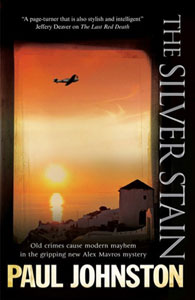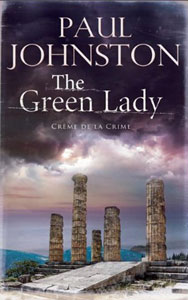 Bringing a PI Back from the Dead
Bringing a PI Back from the Dead
No, not Sherlock. Between 2001 and 2004, I wrote three novels featuring half Greek half Scots missing persons investigator, Alex Mavros. I studied ancient Greek when I was a kid, then the modern language and literature at university; I lived on a small Aegean island for six years in the 90s; and I now spend most of my time in Nafplio, a beautiful seaside town in the Peloponnese. So writing novels set in Greece was inevitable. The career of Mavros has been less straightforward.
The first three novels came out in rapid succession: A Deeper Shade of Blue (later republished as Crying Blue Murder) in 2002; The Last Red Death (winner of the Sherlock Award for Best Detective Novel and featured/reviewed earlier on this site) in 2003; and The Golden Silence in 2004. I was following a template laid down by the late, lamented Michael Dibdin in his excellent Aurelio Zen series set in Italy – use a different location for each book, forcing your detective to come to terms with different customs, mentalities and so on (Zen was a cop rather than a PI, but the principle holds). This meant I could create a composite picture of Greece, alluding both to the modern world and each region’s complex back story, from ancient through Byzantine, Frankish, Ottoman and modern times. Greece really is one of those countries that has too much history.
Being an ambitious fool, I also wanted to make every book different in terms of its location within the crime and thriller genre. Crying Blue Murder was a rural noir set on an island full of white houses; The Last Red Death was a political thriller that rooted contemporary terrorism in World War Two and the terrible Civil War that ensued; and The Golden Silence was an urban gangster story.
All well and good. I developed my protagonist through the books, primarily by using that major Greek social institution, the family. Mavros’s long dead father was a senior Communist, his brother disappeared during the dictatorship of 1967-74, his elderly mother still runs a publishing company, and his sister’s a fashion and gossip journalist. Oh, and there’s his highly strung, on-off girl friend, Niki. She doesn’t get on at all with Mavros’s best friend, the Fat Man, a caustic Commie café owner. As has become apparent to observers across the world in the last couple of years, Greece is run by shadowy special interest groups – plutocrats, media bosses, industrialists, ship owners – that pull the politicians’ strings. Mavros has a habit of uncovering the secrets that those in power would rather didn’t see the light.
 Then Mavros was killed off. Not by me, à la Conan Doyle, or by an assassin, but by my former publishers, who’d had enough of him. My man was thus cast into the outer darkness while I wrote another series, featuring Matt Wells, crime novelist turned tough guy investigator (realism is a major component in crime fiction, yeah?). It was a wrench. When you’ve invested a lot of research and writing time in a set of characters, it’s hard to drop them. But Mavros, who of course shares no personality traits with me whatsoever, stayed alive in my dreams…
Then Mavros was killed off. Not by me, à la Conan Doyle, or by an assassin, but by my former publishers, who’d had enough of him. My man was thus cast into the outer darkness while I wrote another series, featuring Matt Wells, crime novelist turned tough guy investigator (realism is a major component in crime fiction, yeah?). It was a wrench. When you’ve invested a lot of research and writing time in a set of characters, it’s hard to drop them. But Mavros, who of course shares no personality traits with me whatsoever, stayed alive in my dreams…
Until, seven years on, the excellent people at Crème de la Crime decided I could bring the old war horse back, his long hair unaffected by grey since I moved only one year on from The Golden Silence. And so we reach Mavros 4, The Silver Stain (2012). I’d actually written a fairly extensive synopsis of the novel back in 2004, before the series was axed. The location was Crete, the Great Island, which is a fascinating place with many complexities. I decided to focus on the effect of the Second World War, when the island was invaded by the Germans and Italians, and occupied for four years. The initial battle swung to and fro over a week, but the elite Nazi paratroopers and mountain troops eventually prevailed over the Allied forces, who fought bravely in many sectors but were led, as so often, by donkeys. In the story, a Hollywood movie is being made of the invasion, with two survivors – a German who later set up a luxury hotel and a Brit who was a secret agent during the occupation – acting as military advisors. They don’t like each other much…
Mavros is called in to find the female star’s missing PA and soon finds himself in the thick of a vendetta, as well as drug cultivation and the antiquities trade. The question I always ask myself on Crete is why the locals welcome German tourists with open arms, despite the fact that thousands of their compatriots were massacred during the war. It’s a deal with the devil – we take your money, you enjoy our beaches and monuments – but, like all such deals, there’s a cost. At great personal risk, Mavros finds out what it is, as well as uncovering an unsuspected link to his father. I suppose The Silver Stain is an ‘effect of war on families’ kind of book. Family is indeed everything in Greece.
 As is the case in the latest book, The Green Lady (February 2013, US). This time Mavros is on the trail of a missing school girl, whose wealthy father, a member of the 2004 Olympic Games organizing committee, has covered up her disappearance. This sends her mother, English former fashion model Angie, to Mavros – but there’s a catch. He can’t question any family or friends. Other leads send him to the area around the ancient site of Delphi. It’s not all oracles and glorious views, though. There’s an aluminum plant that’s spawned a soulless new town, as well as seriously polluted the environment. Who was the ancient goddess who lost her daughter? Correct, Demeter, the Green Lady of the title. What was the said daughter’s name? Persephone. Who abducted her? Hades, god of the underworld, as well as of minerals and wealth. Yup, you’ve got it. Mavros is on a highway to hell, and he’s taking the Fat Man with him. There’s a vicious killer after him too – just in case he catches a break. In essence, The Green Lady is an eco-thriller, though I hope that doesn’t put anyone off. There are more thrills than er…ecos. On the other hand, echoes (cultural, political, social, mythological, literary) are in abundance.
As is the case in the latest book, The Green Lady (February 2013, US). This time Mavros is on the trail of a missing school girl, whose wealthy father, a member of the 2004 Olympic Games organizing committee, has covered up her disappearance. This sends her mother, English former fashion model Angie, to Mavros – but there’s a catch. He can’t question any family or friends. Other leads send him to the area around the ancient site of Delphi. It’s not all oracles and glorious views, though. There’s an aluminum plant that’s spawned a soulless new town, as well as seriously polluted the environment. Who was the ancient goddess who lost her daughter? Correct, Demeter, the Green Lady of the title. What was the said daughter’s name? Persephone. Who abducted her? Hades, god of the underworld, as well as of minerals and wealth. Yup, you’ve got it. Mavros is on a highway to hell, and he’s taking the Fat Man with him. There’s a vicious killer after him too – just in case he catches a break. In essence, The Green Lady is an eco-thriller, though I hope that doesn’t put anyone off. There are more thrills than er…ecos. On the other hand, echoes (cultural, political, social, mythological, literary) are in abundance.
So what’s it like bringing a favourite character back from the temporarily dead? In a word, good. And not only Mavros, but his sidekicks too. One of the great things about an extended series is that you can have not only goodies but baddies reappearing. An antiquities smuggler from Crying Blue Murder comes back in both the last two books. (Though I doubt he’ll show up again…) Mavros’s cop contact is in all the books, bending the law and as infuriated with the PI as ever. As for the Mavros faithful, welcome back Niki, as unbalanced as a spider with no legs on one side; and the Fat Man, whose aim in life is to be Dr. Watson, though with more homemade pastries.
That’s enough jesting. I’m currently putting the finishing touches to Mavros 6, The Black Life, in which our hero tries to find an Auschwitz survivor, who hasn’t been seen since 1945. Does he have a story to tell. But for that you’ll have to wait till next year.
The Silver Stain and The Green Lady are published by Crème de la Crime in the US and UK.





Charles Wingfield
February 11, 2013 - 3:41 PM